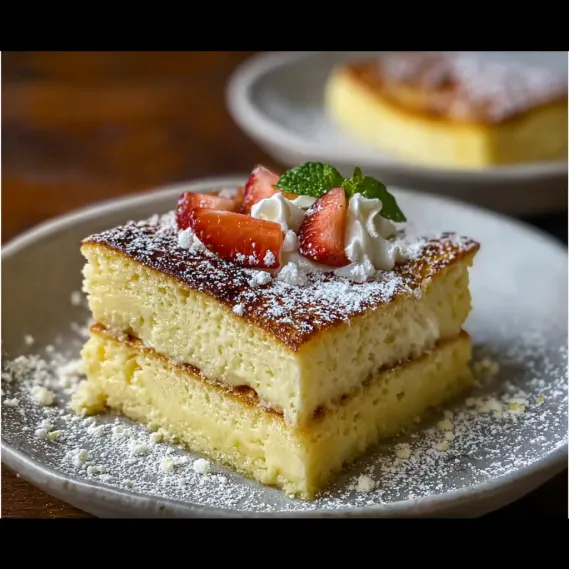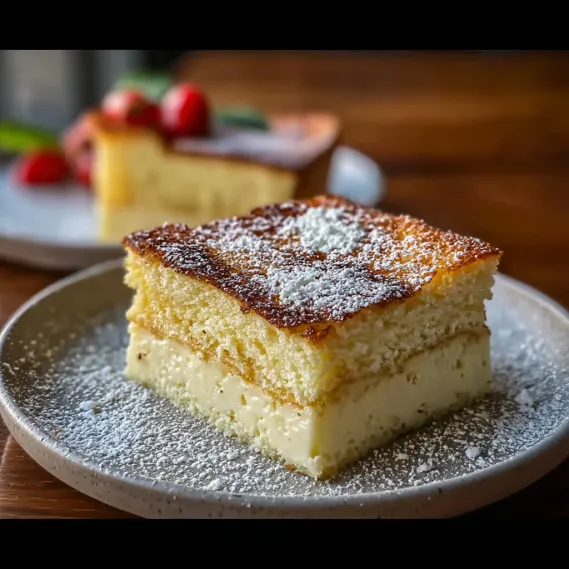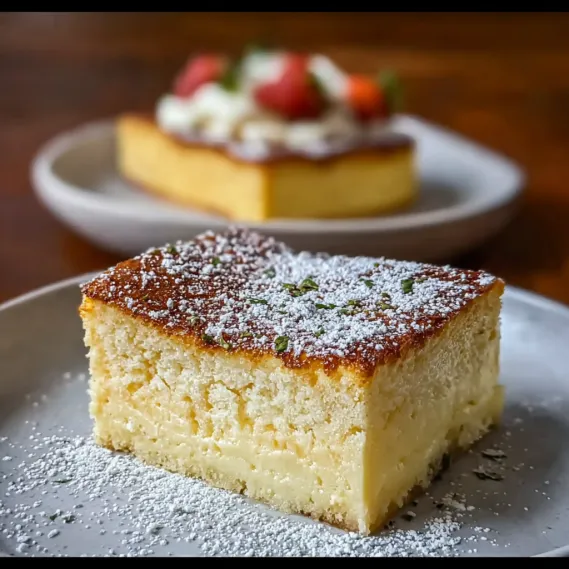 Pin
Pin
Vanilla Magic Custard Cake is that rare dessert where one batter bakes itself into three delightful layers—a light sponge on top, creamy custard in the center, and a softly dense base. It is beloved for its simplicity and the way it fills the kitchen with a nostalgic vanilla aroma. This recipe is a classic for cozy weekends or when you want to surprise guests with something almost too pretty to be so effortless. Every slice feels like a little piece of kitchen alchemy with familiar flavors that make everyone linger a little longer at the table.
My first attempt at this recipe was to recreate my grandmother’s Sunday dessert and just like hers mine had that distinctive delicate custard middle that made the family rave. Now it is my go to whenever I want a dessert that brings comfort and a bit of wow.
Ingredients
- Eggs: four at room temperature provide loft and help the batter separate into layers use the freshest eggs possible for best rise
- Granulated sugar: three fourth cup brings sweetness and assists with the custard texture go for fine sugar if available so it dissolves easily
- Unsalted butter: eight tablespoons melted and slightly cooled adds richness and moisture always choose high quality butter for flavor
- Water: one tablespoon helps with batter consistency
- Vanilla extract: one teaspoon infuses that classic aroma and warmth pick pure vanilla for best results
- All purpose flour: three fourth cup creates the cake’s distinctive structure sift it for easy mixing
- Milk: two cups lukewarm forms the custard layer whole milk is preferred for creaminess so gently heat it just to take the chill off
- Powdered sugar for dusting: adds a pretty finishing touch and a hint of sweetness sift over just before serving
Step by Step Instructions
- Prepare the Baking Dish:
- Before anything else set your oven to 325 degrees Fahrenheit or 160 degrees Celsius. Grease an eight by eight inch baking dish or line it with parchment to make unmolding and cleanup easier.
- Separate the Eggs:
- Take a moment to carefully crack your eggs separating whites and yolks into two large clean bowls. Doing this when the eggs are still cold makes it easier.
- Beat the Egg Yolks with Sugar:
- Using a stand or hand mixer beat the yolks and sugar together until the mix is pale and increases in volume. This often takes about three minutes and helps give the cake a tender crumb.
- Add Butter Water and Vanilla:
- Pour in the melted butter followed by water and vanilla. Mix on medium until everything is smooth and shiny.
- Incorporate the Flour:
- Gradually add flour in a few installments making sure to scrape down the bowl and mix until the batter is lump free and silky but do not overmix.
- Warm the Milk and Add to Batter:
- Gently warm the milk until it is just lukewarm to touch. With the mixer running on low slowly stream it into the batter. The mixture will look thin but this is key for that middle custard.
- Whip the Egg Whites:
- With very clean beaters whip the separated whites until they hold stiff flashy peaks. The bowl should be grease free so the whites get as much air as possible.
- Fold in the Egg Whites:
- Switch to a spatula and gently fold one third of the egg whites into the runny batter to lighten it. Then add the rest in two more additions swirling gently just until combined. A few streaks are fine.
- Bake the Cake:
- Pour the now airy and liquid batter into your dish. Slide it into the oven’s center and bake for fifty to sixty minutes. Watch for a deep golden crust on top while the cake beneath should gently jiggle when shaken.
- Cool and Serve:
- Let the cake cool completely in its pan to allow the layers to set. Just before servings add a snowy dusting of powdered sugar. For the best neatly defined layers chill the cake for several hours and cut with a sharp knife wiped clean between cuts.
 Pin
Pin
One of my favorite moments with this cake was serving it still slightly chilled to friends after a late afternoon walk in autumn. The first forkful always draws a little gasp at how soft yet structured it is and the old fashioned vanilla aroma takes everyone back to childhood afternoons spent in the warmth of the kitchen.
Storage Tips
Once fully cooled place leftover cake in an airtight container. Keep it in the refrigerator for up to three days. For even neater slices partially freeze the cake for thirty minutes before serving. Avoid wrapping directly with plastic as it may stick to the delicate top layer.
Ingredient Substitutions
If you need to make this cake gluten free use a measure for measure blend and sift it thoroughly to prevent lumps. For a lactose free spin substitute your favorite plant milk but keep in mind the custard might not be as rich. Add lemon zest or a sprinkle of cinnamon if you prefer an aromatic twist.
Serving Suggestions
This cake excels on its own but is also wonderful with a spoonful of lightly sweetened berries or a dollop of whipped cream. Serve after a simple dinner or bring to a brunch spread where its magic layers will steal the show.
 Pin
Pin
Cultural and Historical Context
Magic custard cake has roots in European home baking especially across Hungary and France where separate layers blossoming from a single batter is a traditional technique. Its resurgence online made it a viral favorite because it proves that something special can come from the most ordinary ingredients.
Recipe FAQs
- → How do the layers form while baking?
The batter's thin consistency and whipped egg whites allow separation during baking, resulting in a fluffy top, creamy center, and firm base.
- → Can I use different flavorings?
Yes, lemon zest or a sprinkle of cinnamon can be added to the batter for extra flavor while keeping vanilla as the base note.
- → Why should the cake cool completely before serving?
Cooling lets the custard layer set properly and makes slicing cleaner, ensuring distinct layers and better texture in every piece.
- → How can I achieve a firmer custard layer?
Reduce the milk amount slightly to create a more set, firm custard center without losing the cake's characteristic softness.
- → What size baking dish works best?
An 8×8-inch dish is ideal, giving the best ratio of thickness to layered effect. Lining with parchment helps with easy removal.
- → Is this dessert better served chilled or at room temperature?
It's delicious either way, but chilling enhances the texture of the custard center and helps the layers become more defined.
